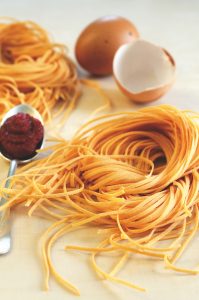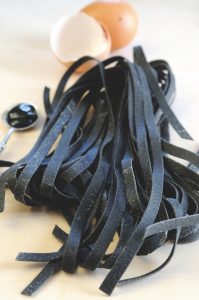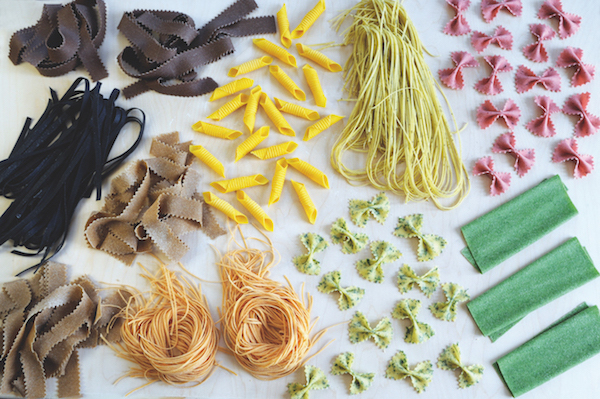In this instalment of his series uncovering the secrets of Italian food, Mario Matassa turns his attention to pasta. Read on for a lesson in how you can make the perfect fresh egg pasta too…
Photos by Mario Matassa
Someone once asked me if it was possible to say that a food is simpatico. This is not a word that translates easily from Italian. It is usually used to mean that a person is nice, congenial, friendly, though something essential is lost in translation. You wouldn’t use it to describe food, but it would go some way in beginning to explain the Italian nation’s love affair with pasta.
A friend suggested to me that being simpatico is like an embrace. So a simpatico food would be one that embraces you; a food for all occasions; a food that can be elegant, simple, rustic or contemporary; a quick meal for the family, or for that special occasion; a food that makes the very best of seasonal variations, warm and comforting on a cold winter’s evening, light and revitalizing on a warm summer’s afternoon; a food that can be as inexpensive or as expensive as you choose; one that can stretch the creative imagination to the limits, or that can be prepared as simply as boiling a kettle and grating a little cheese. Have you ever met anyone who has not cooked a plate of pasta? From children to students, home-cooks to Michelin-starred chefs, it’s quite simply universal. In other words, it’s simpatico!
It should come as no surprise to hear that we Italians eat more pasta than any other nation in the world. The International Pasta Organization estimated that Italians eat on average 28kg of pasta per person per year. To put that into perspective, the average person in the UK consumes a mere 2.5kg. Broken down, the figure of 28kg per year translates as approximately 80g of pasta per person, per day, 365 days of the year. So the figures suggest that the average Italian really does eat a bowl of pasta every day!
 There’s no substitute for fresh
There’s no substitute for fresh
Knowing how to make fresh pasta is a basic survival skill here. There’s no place in an Italian kitchen for anyone who does not know how to make pasta – it’s that fundamental. Outside of Italy, cooks often shy away from the challenge of making pasta, opting instead for the convenience of so-called fresh pasta from the supermarket. To be honest, it’s not something any self-respecting Emilian cook would consider an acceptable alternative. It’s just not the same. Plus, it’s really not difficult to make your own.
It all comes down to this: four eggs, 400g of flour, four litres of water and a tablespoon of salt. That’s roughly the perfect formula for four hungry people. Of course, when it comes to pasta, measurements are at best indicative. It’s a question of understanding how the dough should feel and knowing how environmental conditions will affect the outcome. Different eggs will absorb the flour differently, and on any given day environmental conditions will play a role too. The key is not to get flustered. If the dough feels too crumbly, wet your hands or add a teaspoon of water. If it’s too wet, add flour. If you are an absolute beginner, the easiest thing to do is to add a tablespoon of olive oil. This will make the dough more elastic and easier to work.
 A world of possibilities
A world of possibilities
Once you’ve mastered the basic technique of making the dough and rolling out a sfoglia (sheet) of pasta, the versatility of the nation’s favourite staple really comes to the fore. It’s at this point that you are faced with the really difficult choices. Which sauce are you going to cook? What shape of pasta? What if it’s a special occasion and you want to impress your guests? While normal egg pasta is a solid basis for any Sunday lunch, with just minor alterations to the basic recipe – the infusion of beetroot juice, saffron, peperoncino, the use of chestnut flour or the addition of fresh herbs, such as basil or parsley – your pasta is transformed into any colour or flavour you care to mention.
When it comes to cooking pasta, there are a few guidelines to observe. Fresh pasta cooks quickly, so it should be added once the water is boiling vigorously, and all in one go. Don’t forget to add salt to the water, a little extra if the sauce you are serving is bland. As for olive oil, save it for the salad. Whoever perpetuated the myth that you should add a few drops of olive oil to the water either to stop the pasta sticking or to make the water boil more vigorously didn’t come from Emilia, and most likely buys their pasta from the supermarket.
A flat pasta, such as tagliatelle, will take a mere 20-25 seconds to cook after the water into which it has been dropped returns to the boil. As it should be served immediately. It is important that you are ready to eat, so have your sauce prepared, your cheese grated, and everyone sitting at the table! Click here for Mario’s recipe to make your own fresh pasta.
If you’re feeling confident, these ideas will help add extra interest to your pasta…
Tomato purée
Adding tomato purée not only gives your pasta a glorious colour, it also adds a real Mediterranean kick to the flavour of the finished dish. Pasta made with tomato purée works well, of course, with sauces that incorporate fresh tomatoes and basil. Fresh cheeses, such as ricotta, also go well with tomato-flavoured spaghetti. I have even eaten it with roasted aubergines, finely chopped and mixed into the pasta along with a good drizzle of extra-virgin olive oil and some salted ricotta grated over the top. Here is a great recipe for tomato pasta.
 Cuttlefish
Cuttlefish
Cuttlefish (seppia) is very popular in Italian cuisine. In the past the ink sac of the cuttlefish was used by artists, thereby giving its name to the colour and substance sepia. The ink can be bought in small packets in supermarkets (usually by the fish counter) or Italian speciality stores. It’s tremendously easy to use and can be incorporated into risottos and pasta dishes to dramatic effect.
Cuttlefish-coloured pasta is most often married with seafood. Clams, mussels and squid all work very well. This recipe uses squid, and the key is judging the timing – if it’s cooked too long squid can become somewhat rubbery. Once the pasta is cut and ready to be cooked, prepare your squid and have all your ingredients ready for when the water comes to the boil. Cook the squid quickly over a high heat and it will be meltingly tender. Make this dish to make the most of your cuttlefish pasta.
Wild boar
Cinghiale (wild boar) is one of the most prized meats in Italian cuisine, and every time it is eaten is considered something of an occasion. There are endless variations and techniques for cooking wild boar, but as a rule it tends to be cooked slowly and works well with flavourings reminiscent of the environment in which it is hunted – roasted with juniper berries, in stews with porcini, or cooked with chestnuts and wild fruits. Hunting season here always begins and ends with a dish of cinghiale. Personally, I enjoy it slow-cooked in a stew to the point where it virtually disintegrates, then ladled over polenta. Alternatively, spoon it liberally over pasta for the perfect primo. This is a perfect recipe for cinghiale pasta.
 Spinach
Spinach
Spinach (spinaci) is one of the best-loved of all Italian vegetables and finds its way into many different dishes. Part of the reason for its popularity is its versatility. At its simplest, it’s washed, cooked briefly in its own juices, and served with oil, salt, pepper – sometimes a little peperoncino – and a squeeze of fresh lemon juice.It is also forms the basis for various stuffings for fresh pasta. Combined with fresh ricotta and a dusting of nutmeg, it makes for perfect ravioli. Green spinach pasta – either as tagliatelle or lasagne – is probably the most popular and widely used flavoured pasta. It can be bought dried from the supermarket, but the fresh version is undoubtedly superior. The spinach does not significantly alter the taste of the pasta, merely the appearance. Spinach pasta should be treated in exactly the same way as normal fresh-egg pasta. Try this recipe to showcase your spinach pasta skills.

